Self-service kiosks have gained popularity as a convenient and efficient tool for businesses to enhance customer experience. These interactive digital kiosks enable customers to complete various tasks independently, reducing and even eliminating the need for human assistance. In this comprehensive guide, we will explore the features and benefits of self-serve kiosks, delve into the different types available, and explain why REDYREF is the ideal kiosk manufacturing partner for businesses seeking to implement self-service kiosks.
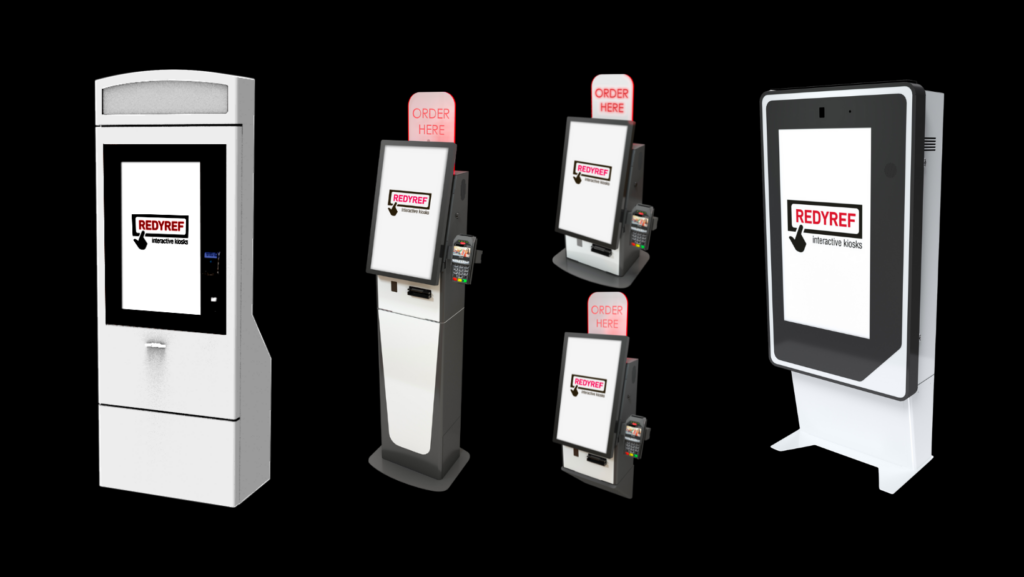
10 Benefits of Self-Service Kiosks
1. Convenience: Provide customers with the convenience of completing tasks on their own schedule and at their own pace, without the need for human interaction. They can be accessed 24/7, allowing customers to use them even outside regular business hours.
2. Efficiency: Streamline processes and operations, reducing wait times and increasing efficiency for both customers and businesses. Customers can quickly complete transactions or access information without waiting in line or relying on staff availability.
3. Accuracy: Reduce errors and increase accuracy, as customers input their own information directly into the kiosk. This eliminates the possibility of miscommunication or data entry mistakes that may occur with human interaction.
4. Customization: Able to display specific information and options based on a customer's preferences, making the experience more personalized. They can provide targeted recommendations or tailored content based on customer preferences or past behavior. The exterior of kiosks can also be customized to reflect a brand or company's identity using vinyl wraps and powder coating or painting.
5. Data Collection: Can collect valuable data on customer behavior and preferences, allowing businesses to make informed decisions about their products and services. This data may be used for analytics, marketing strategies, and improving customer experiences.
6. Increased Customer Engagement: Provide an interactive and engaging experience for customers. They can offer multimedia content, interactive maps, product catalogs, and promotions, enhancing customer engagement and satisfaction.
7. Cost Savings: By reducing the need for additional staff, self-service kiosks can help businesses save on labor costs. They can handle routine tasks, freeing up staff to focus on more complex or customer-centric activities.
8. Upselling and Cross-selling Opportunities: Can prompt customers with additional product recommendations or promotions, increasing opportunities for upselling and cross-selling. This can lead to increased sales and revenue for businesses.
9. Improved Queue Management: Help to alleviate congestion and long queues at service counters, especially during peak hours or busy periods. They provide an additional avenue for customers to complete transactions, reducing wait times and improving overall customer satisfaction.
10. Accessibility: Able to be designed to accommodate individuals with disabilities or special needs. They can offer accessibility features such as larger text sizes, audio output, and tactile interfaces, ensuring inclusivity for all customers.

7 Important Types of Self-Service Kiosks
The most important types of digital self-service kiosks vary depending on the industry and specific business needs. However, some commonly used and important types of self-serve kiosks include:
1. Retail Kiosks: Commonly used in stores to allow customers to place orders, browse products, check product availability, make payments, and even return or exchange items without the need for assistance from a sales associate. They enhance the shopping experience and provide convenience for customers.
2. Foodservice Kiosks: Utilized in restaurants, fast-food chains, and cafes to allow customers to place orders, customize their meals, and make pay for their orders. These kiosks can streamline the ordering and payment process, reduce wait times, and offer options for menu customization.
3. Financial Kiosks: Banks, credit unions, and other financial institutions use self-service kiosks to help customers to perform various transactions such as depositing or withdrawing money, checking account balances, transferring funds, and printing statements. These kiosks provide convenience and accessibility for customers while reducing wait times at traditional teller counters.
4. Ticketing Kiosks: Used in entertainment venues, transportation hubs, and attractions to allow customers to purchase tickets for movies, concerts, flights, trains, buses, theme parks, and more. These kiosks provide a self-service option for ticket purchases, reducing long queues and providing a quick and efficient ticketing experience.
5. Healthcare Kiosks: Healthcare facilities, clinics, and hospitals utilize self-service kiosks to allow patients to check-in, update personal information, schedule appointments, make payments, and access health-related resources. These kiosks improve patient flow, reduce administrative workload, and enhance the overall patient experience.
6. Informational Kiosks: Placed in public spaces, tourist attractions, transportation hubs, and shopping malls to provide visitors with information such as maps, directions, event schedules, and facility directories. These kiosks help users navigate their surroundings and find the information they need quickly and easily.
7. Interactive Wayfinding Kiosks: Found in large venues like airports, shopping centers, and convention centers and provide visitors with detailed maps, directions, and information about different points of interest within the venue. These kiosks assist in guiding visitors and enhancing their overall experience by providing real-time information.
While these are some of the most important types of self-service kiosks, there are various other specialized kiosks tailored to specific industries and business requirements. The key is to identify the needs of the business and its customers to determine the most relevant and beneficial types of self-service kiosks to implement.
Why REDYREF is the Right Self-Service Kiosk Manufacturing Partner
As a leading manufacturer, REDYREF offers customizable, high-quality indoor and outdoor kiosks with over 100 years of combined experience. Our interactive self-service kiosks are designed to be easy to use, reliable, and customizable and can include a full range of features including touchscreen displays, payment processing capabilities, and data collection. We also offer a comprehensive support system post-purchase, including installation, maintenance, and repair services to ensure kiosks are always up and operational.
Self-service kiosks have become essential for businesses aiming to provide convenient and efficient customer experiences. With their convenience, efficiency, and accuracy, self-service kiosks can be employed in various industries. REDYREF stands as the ideal kiosk manufacturing partner, offering businesses high-quality, customizable kiosks designed to be user-friendly, reliable, and efficient. Interested in learning more? Contact us today!
Although there are church congregations that have remained smaller, big churches are becoming more and more common. These facilities, sometimes called “mega-churches,” may have multiple services per day for upwards of a thousand people during each time slot. Because of this, church security has become a bigger concern, especially when it comes to children’s safety within larger facilities. Tracking attendance and knowing exactly who is in the building at a given time has therefore become increasingly important.
Some churches have chosen to start using Church Management Software to understand who is in the building, and when. This software is an all-in-one solution that also helps churches manage their membership and link everything back to their accounting software, while facilitating and securing the church check-in process.
Traditional Attendance Taking vs. Digital Church Check-In Kiosks
Traditionally, churches have tracked attendance manually via approximate head counts and sign-in sheets. However, this simply isn’t feasible for large churches, as they tend to lack the degree of detail and accuracy needed to ensure a safe environment. This is especially true for those churches with multiple services, classes or other events occurring daily.
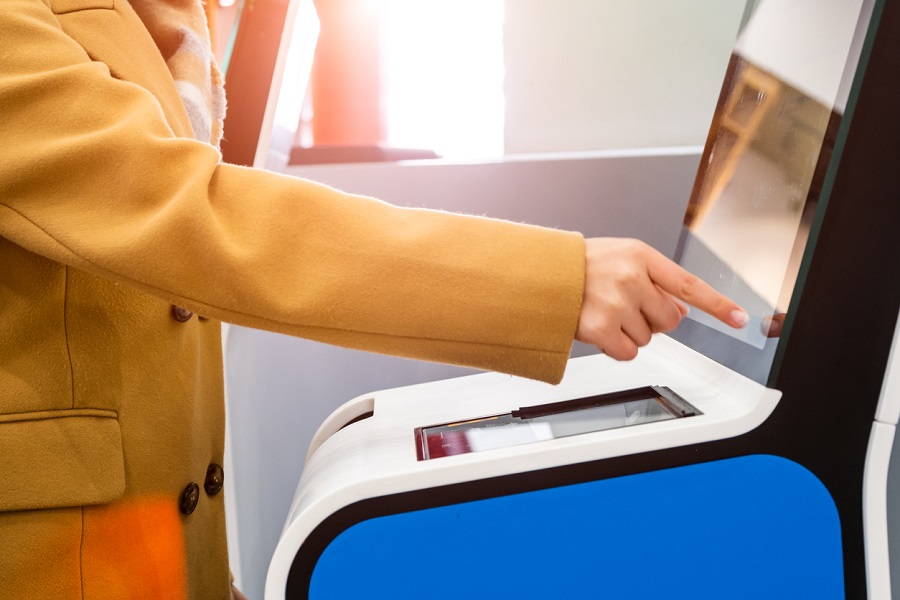
This is why modern churches, especially those with big congregations or memberships, often choose digital check-in kiosk systems to track attendance and increase the security of their facilities. These may include larger kiosks integrated with specialized software and displays or smaller table-top kiosks outfitted with tablet computers. These solutions can include components like barcode scanners, name tag printers and fingerprint scanners to make check-in more accurate, secure and efficient, and are usually able to be integrated with existing church management software. This allows most of a church’s administrative software to work together, from volunteer management and member directories, to attendance tracking and billing.
Church Check-In Kiosk Features
Church check-in kiosk solutions can be unique, however, most of them provide a core set of self-service features, including:
- Mobile check-in accessible by members and visitors via smartphone
- Kiosk check-in for those who wish to use the on-site system
- Virtual check-in for members who attend services online or on satellite campuses
- Volunteer check-in for events or meetings
- Payment processing components and integrations for donations or payment of dues, fees or classes and event costs.
- Barcode scanning for use at ticketed events
- Attendance tracking for specific services, events or meetings
- Badge and nametag printing for large events where members may not know everyone in attendance, or for classes and Sunday School
Benefits of a Self-Service Kiosk in Church
- Facilitate simpler and more efficient check-in
- Offer greater security for larger events, or those in which children may be under the supervision of those who are not parents or guardians, such as childcare environments
- Enable more accurate attendance tracking and activity management
- Create opportunities to advertise or promote upcoming events
- Make the tithing, donation and payment process easier
- Offer the versatility required by growing congregations

Improving the Security of Churches to Keep Children and Other Members Safe
Because digital kiosks are adaptable and able to meet a wide range of church needs, they are also flexible enough to play a significant role in increasing facility security, especially for the congregation’s youngest members. In fact, most church kiosk systems are even able to be secured in ways that limit access to administrative functions to only approved church employees and volunteers, allowing for an even greater degree of security when it pertains to the security of children, especially during pick-ups and drop-offs.
With this enhanced security functionality at the core of church check-in kiosks, it’s clear why so many churches have already implemented these systems in their facilities. They help protect the church by securing sensitive information, while allowing for better management of church activities and events, improving attendance tracking and ultimately, increasing the quality of the church’s programming.
A kiosk is an enclosure that is designed to hold a digital display as well as a computer and any necessary components or integrations. They are most often placed in higher-traffic areas in order to reach as many users as possible.
The word “kiosk” originally referred to the freestanding, 4-sided “miniature stores” found in malls and on city streets that offer specialty products from small businesses, or refreshments and newspapers/magazines.
Kiosk Definition & Examples
Over the years, the definition of a “kiosk” has evolved, and now also refers to self-service, digital kiosk systems, like those that allow self-payment or self-checkout. Kiosks can be used to complete any number of functions, from the simple to the complex, and may include an interactive touchscreen or a simpler static display, depending on the functionality required.

While they have been growing in popularity over the past decade, the COVID-19 pandemic has sped their adoption and made them more common even in small business environments. In fact, the kiosk industry is projected to grow at a CAGR of 7.1% from 2022 to 2030. From McDonald’s’ self-ordering kiosks, to large, interactive mall directory displays, kiosks are now found just about everywhere.
Temperature Kiosk
COVID-19 created a demand for technology that would allow organizations to operate as safely as possible. One of the most popular solutions continues to be temperature kiosks, which help companies provide consistent, proactive monitoring for symptoms like fevers in employees, guests and visitors.
Temperature-check kiosks scan the user with a touchless infrared camera using advanced thermal imagery. If the temperature sensor detects a fever, it issues an alert to both the users and assigned staff via email or text/SMS messaging.
Many organizations that operate indoors or in close quarters with large groups of people use temperature-check kiosks to screen for fevers. These include:
- Corporate business offices
- Hospitals
- Entertainment venues like stadiums, concert halls and arenas
- Museums
- Airlines
- Restaurants
Self-Service Kiosk
A self-service kiosk allows users to complete transactions or obtain information without assistance from a store associate or agent. They make many processes more efficient, including payment, check-in, and information acquisition, which reduces wait times and boosts customer satisfaction. Depending on the configuration and software, self-service kiosks can provide a wide range of services, including:
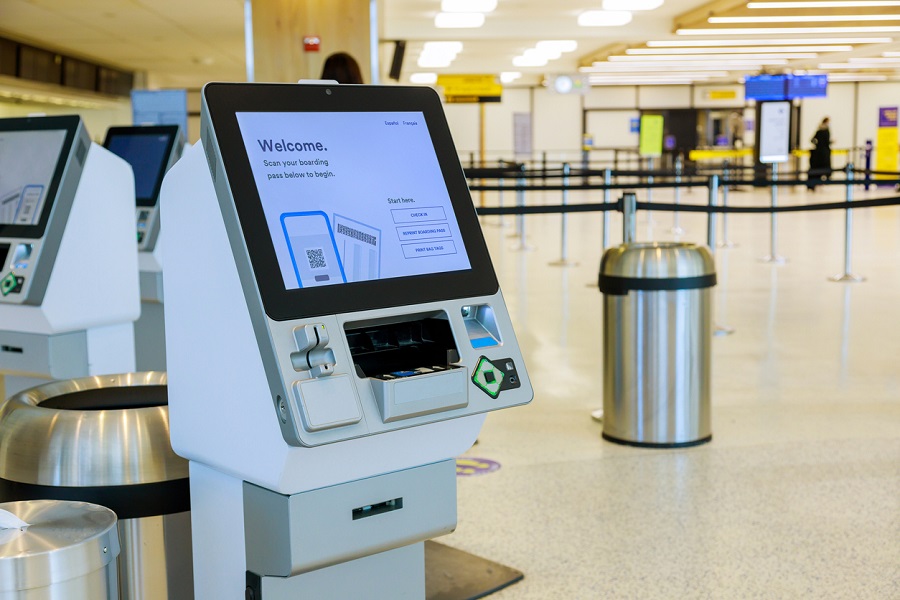
- Self-ordering in restaurants (fast food [QSRs], full-service and quick service)
- Self-payment and ticketing in entertainment venues, movie theaters and transportation hubs like bus depots and train stations
- Self-check-in hotels
- Self-baggage tagging in airports
- Wayfinding in Smart Cities
- Banking via ATMs
- Visitor and employee management in office buildings and healthcare campuses (employee sign-in/out for security)
Information Kiosk
An information kiosk displays information in a clear and easy-to-understand format that the user is able to access without assistance. The type of data available varies greatly and is dependent on the type of software and components that are chosen for the kiosk. These may include
- Local area information and weather
- Wayfinding and maps
- Employee, office or building directories
- Searchable databases for organizations like libraries and retail stores that want to offer guests the opportunity to find items without assistance from an employee
Information kiosks may be designed and manufactured with either interactive displays or non-touch displays. It’s important to keep in mind that If the kiosk is meant to offer a great deal of interactivity, most would require a touchscreen display.
Internet Kiosk
Internet kiosks are found in public places and are most often deployed as part of a “Smart City” kiosk program in urban environments. They generally provide free WiFi access, but occasionally these kiosks require a small fee to be paid before they can be used. They may also include limited internet search functionality via a web browser.
Internet kiosks can be deployed indoors or out, depending on the enclosure selected. One of the biggest advantages of an internet kiosk is that they are rugged and designed to withstand heavy use, and unlike a computer in a business center, are difficult to abuse or vandalize. Additionally, they are locked down by proprietary software that makes it unlikely that they are able to be used in malicious ways, as well as additional programs that make them hard to be “broken into” by a cyber hacker.
Wayfinding Kiosk
Digital wayfinding kiosks can improve visitor, guest, and customer experience by allowing them to find information about their surroundings and access directions unassisted. Depending on their configuration and installed software, wayfinding kiosks can include many helpful services, including:
- Turn-by-turn directions
- Interactive maps -- both 2D and 3D -- which allow users to see different building floors and navigate to and within them easily
- Lighted paths
- Kiosk-to-phone mobile hand-off via text/SMS
This type of kiosk is most commonly used in environments that span a large area, such as healthcare and educational campuses, shopping centers and airports.
Advertising Kiosks & Standing Displays
Advertising kiosks are used for marketing and branding purposes. These kiosks generally feature large display sizes in attractive enclosures, and may be freestanding or wall-mounted (some are even ceiling-mounted, especially in shopping centers). Because companies often pay for digital “space” for their ads on these kiosks based on how many “impressions” or views their ads are expected to receive, they tend to be placed in environments that receive heavy, consistent foot traffic.
Advertising displays allow businesses to communicate information to those passing by about sales, new products, loyalty programs or events, and to encourage guests to visit their stores or find them online. Content can be easily switched out and scheduled remotely. Digital advertising kiosks are also popular for displaying QR codes to engage mobile users who can scan the code and conveniently access more information about a company, brand, product or service right on their smartphones.
Benefits of Kiosks
Digital kiosks can provide organizations with a wide range of benefits, including:
- Increased efficiency
- Cost savings
- Reduced overhead
- Better quality outcomes
- Enhanced customer experience & less frustration
- Marketing opportunities
- Increased brand awareness
- Operational improvements
- Greater advertising reach
Ultimately, listening to what customers need and finding a way to provide them with what it is they are looking for is the best way to ensure their loyalty and satisfaction. While some of these needs may not be able to be automated, others, like reduced wait times, can easily be improved by self-service kiosks. While the initial cost may be substantial, the ROI -- in both revenue and guest satisfaction -- makes kiosks well worth the investment.
Outdoor digital kiosks’ overall use has grown rapidly over the past decade, and the number of different uses for them has grown at an equally rapid pace. From ballparks to college campuses, it seems that just about everyone is starting to ways to integrate outdoor kiosks that benefit both their users and their organizations.
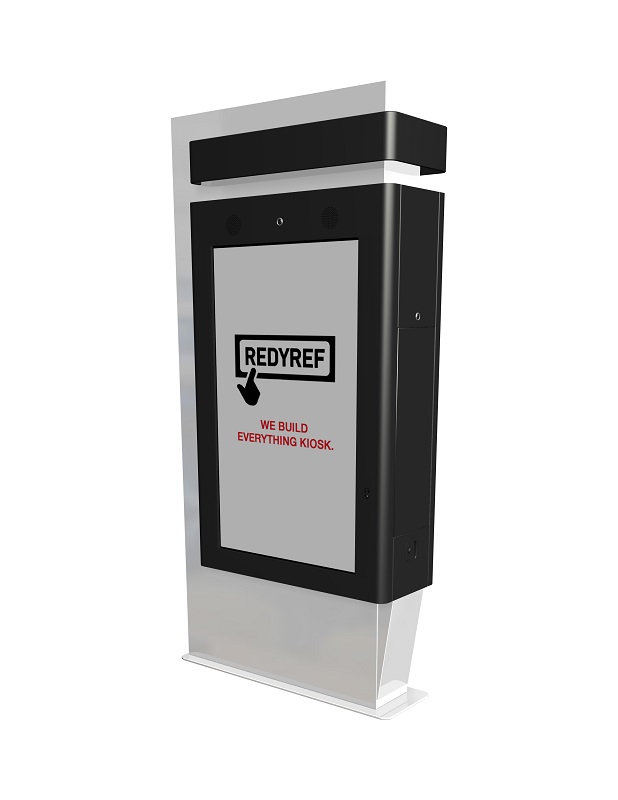
1) Promotion and Marketing
Outdoor digital kiosks are a great way to engage customers or enhance brands’ images. As they tend to be installed in areas with high levels of foot traffic, they allow marketing campaigns and promotions to reach a large number of people at once.
These types of kiosks can be freestanding, attached to buildings, or even to “street furniture,” such as outdoor benches. One of the most popular types of outdoor digital advertising kiosks are Smart City kiosks. These kiosks have multiple uses, including wayfinding and wifi, but feature “attract” screens that rotate through ads for local, regional and national businesses.
2) Parking Management
Paid parking environments have been transitioning to outdoor digital payment kiosks for well over a decade now, with street parking meters leading the way. But over the past few years, parking lots and garages have been following suit. For anyone who has ever searched their entire car for enough change to “pay the meter,” parking kiosks have felt like nothing short of a miracle.
With fewer and fewer people carrying cash, let alone change, this transition makes complete sense for both consumers and the spaces’ owners. Parking kiosks allow payment to be made easily via card swipe or tap, and tickets may be physically printed, or even digitally transmitted to the user’s phone. This also keeps the stress of lost parking tickets from ever becoming an issue. For instance, if you’ve ever lost your parking ticket from an airport garage, you can see how this would be an enormous benefit!
3) Food Ordering and Self-Payment
One of the most interesting uses of outdoor digital kiosks is found in amusement parks. While it may seem strange to think about ordering food at a fast-food restaurant while outside, at an amusement park, that’s sometimes the only viable environment in which to order. This is especially true when you have small kids in tow who aren’t about to patiently wait to eat at one of the few available restaurants.
Food ordering and self-payment kiosks are used to speed up the ordering process and decrease wait times. A few taps on the screen and a swipe later gets a family closer to their giant soft pretzels and slushies more quickly than ever before, while taking a little bit of stress away from parents at the same time.
4) Ticket Printing
Outdoor ticket printing kiosks are often found at venues like ballparks and stadiums, both of which are sometimes used for concerts or other types of live entertainment. These kiosks can be used to buy day-of tickets to events, or to purchase tickets for future events while at the venue. For instance, a visitor may be attending a baseball game that day, but notice while buying same-day tickets at the stadium that in 2 weeks, there is a game on the schedule against their team’s biggest rival. The kiosk offers them a convenient opportunity to purchase both sets of tickets at the same time.
5) Emissions Testing
One of the newest uses for outdoor digital kiosks is for vehicle emissions testing. While not all states require it, many do, and it’s considered to be one of the least convenient things drivers in these states have to deal with. In order to renew their vehicle’s registration and tags, car owners must have their emissions checked, first. These outdoor kiosks can be placed in almost any outdoor location, allowing drivers to complete testing anytime, anywhere. They simply enter or scan the information in the letter sent to them by their state of registration, swipe or tap to pay for the test, and then connect the testing device built into the kiosk to their car. Post-test, they take the printed receipt which tells them whether their vehicle passed or failed. All of this can be completed in about 15 minutes, flat, without the need for an attendant’s assistance.
6) Events and News
There are many great examples of using outdoor digital kiosks for communication purposes, but one of the best is their use on college campuses. These kiosks offer schools an opportunity to speak directly to students, educators and visitors about anything important, including school events like upcoming plays or concerts, to news or reminders about tuition payment deadlines or class sign-ups.
Benefits of Outdoor Kiosks
Outdoor kiosks have many benefits to both users and the organizations who choose to deploy them.
1) Showcasing New and Relevant Information
Outdoor digital kiosks allow organizations a way to directly communicate with a given audience. In a large city, they may be used to announce changes to health protocols, such as indoor masking requirements, helping to protect public health. In an amusement park, they are able to showcase information about new rides and attractions, including wait times, or even new restaurant or food kiosk menu items, offering an opportunity to increase sales or customer time in the park.
2) Wayfinding Assistance
Smart City kiosks and those outdoor digital kiosks round on college campuses can be essential tools for those who are unfamiliar with the area. In large cities, they can help familiarize visitors with their surroundings, giving them a level of comfort that makes it more likely they’ll return. On educational campuses, especially those of big state schools, they are incredibly helpful for new students who may not know their way around. These kiosks offer an easy way for these users to become more comfortable with their environment during what it often already a fairly stressful time – starting college.
3) Promoting Local Businesses
Advertising can be expensive, and for small local businesses, it can be so much so that it makes paid advertising nearly impossible to fit into their budgets. Outdoor digital kiosks offer a more affordable way for local businesses to advertise their good and services. Because these kiosks rotate through a variety of digital ads, the cost is divided among multiple businesses, depending on how big the ad is, how frequently it’s shown and where, the time of day it runs, and how long it stays visible at a time. This makes it a more flexible and affordable option that ultimately benefits both the kiosk’s owner, and the business that advertises.
4) Increasing Customer Engagement
Organizations are found many interesting ways to use digital outdoor kiosks to increase audience engagement. For instance, integrated cameras connected to wifi can allow users to take photos of themselves and their friends in their current environment, and have them sent directly to their smartphones. Some of the more sophisticated kiosks even utilize augmented reality (AR), incorporating famous landmarks or signature products into the photo automatically. Other businesses have gamified their kiosks with built-in apps that require the user’s physical engagement in order to play them. These games generally feature new products or services that the company is working to promote. Using kiosks to increase customer engagement in ways that creates a positive user experience can help enhance a brand’s image and ultimately increase revenue and loyalty.
5) Convenience via Self-Service
Self-service kiosks have grown in popularity for years now, but the COVID-19 pandemic spurred growth like never before. This has forced more customers to become used to self-service technologies much more quickly than they might have, previously. Outdoor kiosks are no different, as they give users a way to complete transactions or get help without interacting with a representative or agent. From outdoor airport check-in and luggage tagging kiosks, to outdoor wayfinding directories, these kiosks offer convenience to users while decreasing overhead via automation for the organizations that deploy them.
Why Should Organizations Invest in Outdoor Digital Kiosks?
While an outdoor digital kiosk can be a serious investment, the many benefits make it clear why they are often well worth considering.
1) Decreased Overhead
Outdoor digital kiosks can help decrease overhead costs associated with staffing. Many simpler tasks that don’t require a live agent or associate can be handled by kiosks.
2) Automation
Automating tasks with outdoor digital kiosks can help eliminate human error and speed up the processing of simpler transactions.
3) Better Customer Experience
When simpler interactions are transferred to a self-service kiosk, it allows users the freedom to find the information they need or make the transactions they need without tracking down a customer service representative or other employee. Kiosks can also be faster than people wh3en certain tasks have been automated. This can save them precious time during what’s likely a busy day, leaving them happier than when they first arrived, therefore enhancing the company’s or organization’s overall image.
Get Started with Outdoor Kiosks
With 100+ years of experience as a leading American kiosk manufacturer, REDYREF has the expertise to design, manufacture and deploy digital outdoor kiosks for almost any environment. Interested in learning more? Request an online quote for your kiosk project, or call 1.800.628.3603 for additional information.
For those of us old enough to remember, there was little quite as irritating as analog parking meters when visiting a busy city center. Fishing around for change, figuring out how much time was available to do whatever needed to be done, then losing track of time, creating a panicked rush out the door to feed the meter, only to find a parking ticket on the windshield (of course). Thankfully, modern digital kiosks have made parking simpler, easier, and more convenient for users, and a better investment for lot and garage owners.
What is a Parking Payment Kiosk?
Parking payment kiosks have been around since 1935; at that time, of course, they were simply known as “parking meters.” While some examples of coin-operated analog meters still exist today, most self-paid parking, whether in a garage or on the street, is handled by digital payment kiosks.
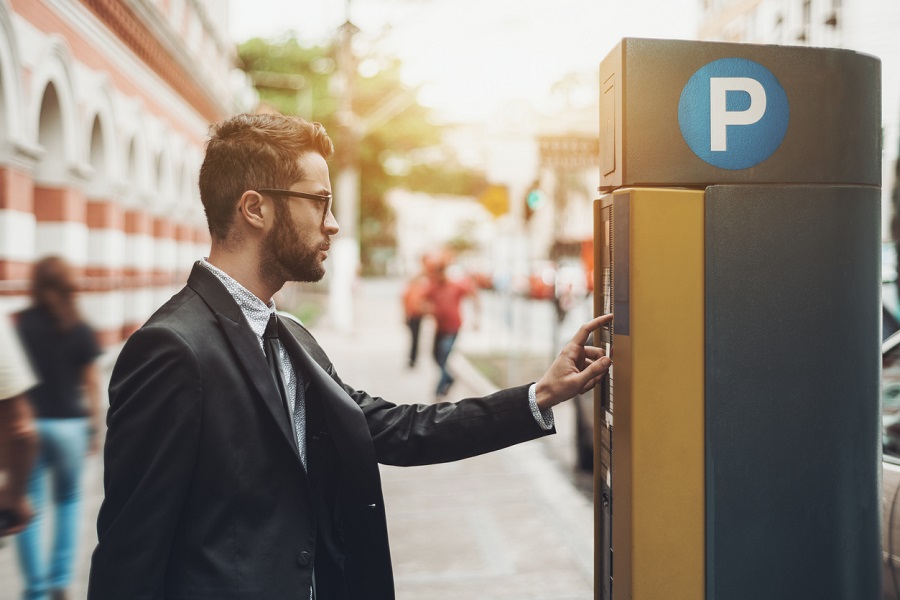
These kiosks allow visitors to pay for parking directly at the kiosk via credit or debit card (and yes, some do still take physical bills, although that is becoming less and less common), or via a connected app.
The Importance of Parking Payment Kiosks for Owners and Operators
Digital self-payment parking kiosks have quite a few advantages over simple parking meters for those who install them. Since many only accept digital payments, there is no need to hire staff to collect coins or bills or replace bills needed in order to make change. This also reduces wear and tear on the units. They are easier to update, too.
If the cost to park changes, most digital kiosks can be updated remotely with that information, rather than physically adjusted in some way. Additionally, digital kiosks can be equipped with monitoring software that can tell a central system if something is wrong with software or hardware, as well as collect useful data, such as total usage and current capacity.
Where are Parking Kiosks Used?
- City Parking Garages and Lots: Many cities own some or all of the parking garages within their boundaries. They are especially common for government buildings, like courthouses. The proceeds from paid parking generally goes toward funding city-run programs that benefit residents.
- City Street Parking: Most large cities as well as many smaller downtowns or town squares use digital marketing kiosks along their streets, also as a way to fund city programs.
- Privately Owned Parking Lots and Garages: It is not unusual, especially in big cities or county seats, for parking lots and garages to be built on privately-owned land. In these cases, the owner may be approached by a management company who will build and maintain the parking area, essentially leasing it from the owner. Or, the owner may decide to build and manage the parking directly, on their own.
Types of Self-Payment Parking Kiosks
There are several types of digital self-pay parking kiosks available.
1. Street Parking Payment Kiosk (Parking Meter Kiosk)
Street parking kiosks can be found in most cities, often for spots that require parallel parking, but sometimes, on a more limited basis, for traditional parking directly in front of popular store fronts. These kiosks are frequently able to be accessed both directly and by mobile app.
It’s common to see these types of digital kiosks placed at regular intervals on streets where paying for parking is necessary, to prevent the user from having to walk long distances looking for the nearest kiosk location. These kiosks require payment at the time parking begins.
2. Non-Gated Parking Lot Payment Kiosk
These are most common in paid surface parking lots, and are usually able to be accessed both directly and by mobile app. The difference between these kiosks and street parking kiosks is that only one, centrally placed kiosk is needed in order to handle a large number of cars.
Occasionally, several kiosks are placed in the same lot, but that is largely for the convenience of the user. These kiosks also require payment at the time parking begins.
3. Gated Parking Payment Kiosk
Unlike non-gated street or lot parking kiosks, most gated parking kiosks still require printed tickets that are used when it comes time to pay at the end of the user’s visit, which then triggers the gate to open. However, non-gated parking garages and lots are becoming more common; these do not require tickets, and use the same technology as the other two types of kiosks mentioned above.
What are the Main Functions of a Digital Self-Pay Parking Kiosk?
Parking kiosks are able to perform a number of functions, including:
- Ticket printing
- Ticket scanning
- Payment processing
- Receipt printing
- Parking status information i.e. time remaining before a paid extension is required
- Capacity information including open levels and spaces
- Garage and lot access control (when a physical gate is present)
How Do Self-Payment Parking Kiosks Work?
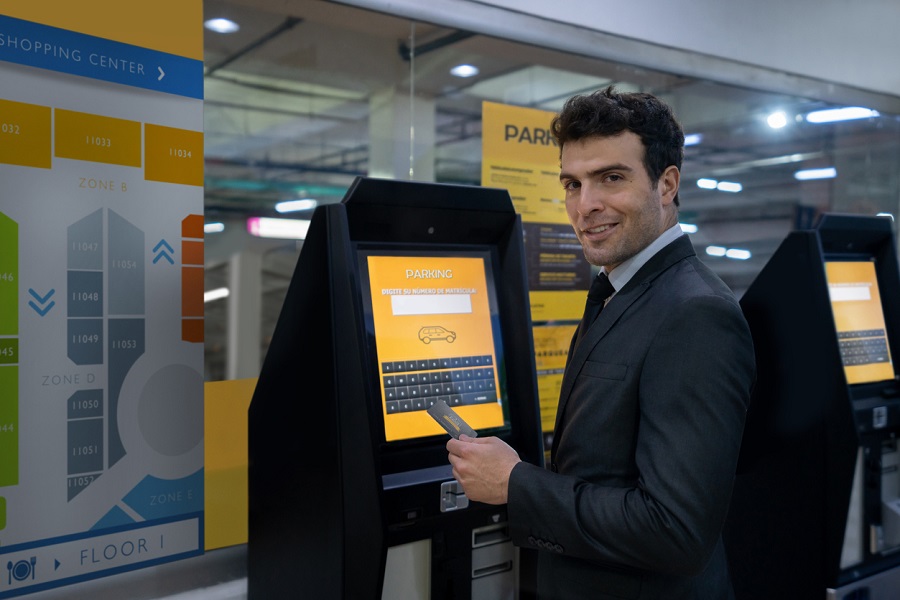
Most digital parking kiosks are not difficult to operate. Many people who frequently park in the same area or lot choose to download the connected mobile app for their phone in order to make the process even more efficient and convenient.
1. For non-gated lots and garages, the user chooses a parking space. * In gated parking areas, the space is chosen later
2. User accesses the parking kiosk directly or via mobile app
3. For non-gated lots and garages, depending on how the kiosk’s software is configured, the user then inputs either a parking space number, or their license plate information, including alpha numeric characters and state of registration.
In gated lots and garages, the kiosk dispenses a physical ticket or creates a mobile device-scannable digital ticket via QR code
4. Non-gated parking lots and garages require payment in advance. The cost may be a fixed, flat rate, or an hourly rate. Hourly rates can often be paid in smaller or larger increments, from as little as 15 minutes to as much as several hours at a time.
Gated parking lots do not require payment until the visit is completed. At this time, their physical or digital ticket can be scanned at the kiosk, payment made, and receipt printed or sent to the user via SMS. The gate is then lifted to allow exit from the parking area.
While there are still digital kiosks that can process cash payments, most are moving to all digital payment processing via credit or debit card
What are the Benefits of Self-Payment Parking Garage Kiosks?
Self-pay digital parking kiosks can have many benefits for owners and operators.
Better data and enhanced reporting
Because these kiosks are digital, they are able to provide value back to the owner or operator that goes beyond what is collected in payments in the form of data. This data can help inform decisions regarding capacity planning and pricing, as well as report on usage trends.
Decreased overhead
Digital self-pay parking kiosks don’t need to be staffed by multiple employees, which decreases the total overhead necessary for their operation. In fact, many don’t staff their physical kiosks at all, instead opting for the integration of a “call” button that can contact a centralized office for assistance were help to be needed by the user.
Simplified Maintenance
Because parking payment kiosks are machines – albeit more sophisticated ones than their analog predecessors – they can, of course, break down. However, as digital machines, many of the issues that may arise can be fixed remotely with software or firmware updates. On the occasion that a physical part of the kiosk experiences problems, extended warranties and service contracts can play an important role in keeping the cost of ownership down and overall ROI up.
Ease of Use for Customers
Most people have grown accustomed to using digital kiosks, and almost expect the convenience of them available for handling automated processes. Self-payment parking kiosks are no exception, especially when combined with mobile app access.
Why Choose REDYREF to Design and Manufacture Digital Parking Payment Kiosks?
With more than 100 years of kiosk manufacturing experience, REDYREF is able to customize self-payment solutions including those for parking lots, garages, and street parking. Whether for public or private entities, REDYREF helps increase operating efficiencies for parking establishment owners. Interested in learning more? Request an online quote for your digital parking kiosk project, or call 1.800.628.3603 for additional information.
The popularity of digital directories and touchscreen wayfinding kiosks has been growing steadily over the last decade, but in particular, the last several years. There are few industries left that haven’t found a way to utilize this type of technology for their benefit and the benefit of their users. Educational environments are no exception, and self-service kiosks are becoming a common sight at all levels, from K-12 schools to college and university campuses.

What are the Benefits of Kiosks in Educational Environments?
Kiosks can offer many benefits in educational settings, including:
- Creating efficiencies
- Decreasing certain types of overhead costs
- Increasing student engagement
- Enhancing communication
- Visitor management
- Emergency messaging
Who Benefits from Digital School Kiosks?
Almost anyone who interacts with or within schools can benefit from digital kiosks. Parents and guardians, teachers, vendors, staff and students can all use use kiosks to create a better educational experience at all levels, including:
- K-5 (lower and upper elementary schools)
- Middle schools and high schools (secondary schools)
- Colleges and universities
- Trade schools
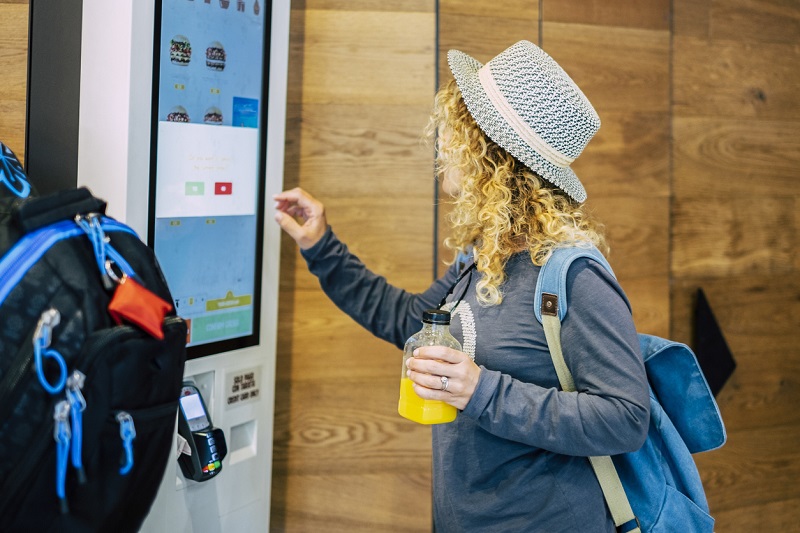
How are Kiosks Used in Schools and Universities?
There are any number of ways digital kiosks can be used in educational settings:
1. School visitor management
One of the most common and most important ways schools use self-service kiosks is to monitor visitor and student check-in and check-out. It has become an increasingly necessary way to enhance school safety, tracking who is in the building at any given time. It is also helpful for parents of older kids, who are able to see when their child checks in or out of school independently, such as for doctors appointments or other non-school activities with email or sms alerts.
2. School tuition payment
Private K-12 schools, universities and colleges can use self-service kiosks to allow students, parents and guardians to pay for tuition while on campus. These kiosks can also be used in university book stores to pay for school books and other supplies.
3. Wayfinding and navigation
One of the most stressful parts of starting college, especially at a large university, is learning how to navigate the campus and various buildings. Wayfinding and directory kiosks can make it easier for new students, as well as visitors, guests and vendors, to find their way around without getting lost and without extra worry or concern.
4. Event communication
Most schools, whether at the K-12 or university level, have any number of events happening at a given time. From theater and music programs, to academic or social meet-ups to school sports practices and games, digital kiosks offer ways to display all types of event information in a clear and organized fashion.
5. Emergency management
In the case of a school or campus-wide emergency, digital kiosks can play an important role in keeping students, teachers and staff safe by communicating instructions in real time. Local emergencies, such as extreme weather, can also be broadcast via digital means.
6. Room scheduling, status and information
Most colleges and universities have shared classrooms, with students, instructors and professors switching in and out of a given room or auditorium throughout the day. Digital signs can be placed outside of each room and programmed remotely with information that changes as classes rotate through, helping students to identify where they need to be, including if there are last-minute changes in class locations. For spaces that can be reserved, like conference or study rooms, students and staff can check availability and reserve rooms ahead of time for their needs.
7. Staff and student wellness/temperature checks
The pandemic has permanently changed the way most people think about their own health and wellness as well as that of others. Keeping schools open and safe has become a priority, even as infections have surged and waned. Post-pandemic, it’s likely that regular temperature checks and wellness questionnaires will still need required in some environments, especially when social distancing isn’t possible, such as classroom settings. Digital kiosks can provide these via self-service options, helping to prevent the spread of infection in both schools and colleges.
8. Cafeterias
School cafeterias can use self-service kiosks to check students in at dining halls and cafeterias, using their school IDs. While this is currently more common at colleges and universities, K-12 schools are now moving toward this model, too, decreasing the need for additional staff, and fully digitizing payments.
9. Student center ordering and payment
Most universities have student centers that allow students to gather to socialize or study, and almost all feature some sort of cafe or other place to grab coffee or a snack. Self-order/self-pay kiosks let students get what they need and go using a digital payment source, such as a debit card, or student ID that acts much like a debit card. Additionally, some larger colleges have multiple quick-service or fast-food restaurants right on campus, and most will accept the same payment methods as those that are owned by the university for students’ self-purchases.
Why Choose REDYREF for School and University Kiosks?
With more than 100 years of experience as a leading American kiosk manufacturer, REDYREF has the expertise to build digital and self-service kiosks for any educational environment. From self-payment and visitor management, to wayfinding and communication, REDYREF knows how to create the best and most efficient kiosk solution for school and university needs. Interested in learning more? Request an online quote for your kiosk project, or call 1.800.628.3603 for additional information.
Self-service kiosks have been around for quite some time, but only in the past decade (and in particular, the last several years) have they become a truly common sight. Many branches of state, local and federal governments are also moving toward digital kiosk technology to help improve, simplify and streamline operations.
What are Self-Service Kiosks?
Digital self-service kiosks provide organizations a low- or no-contact way of interacting with their visitors, customers or guests. They offer the ability to order, pay, print tickets, assist with navigation and wayfinding, or allow for self-check in, to name just a few of the available options. These kiosks can be freestanding, wall-mounted or counter-mounted, and are able to be configured with full-size computers and large displays or as smaller, simpler tablet solutions.
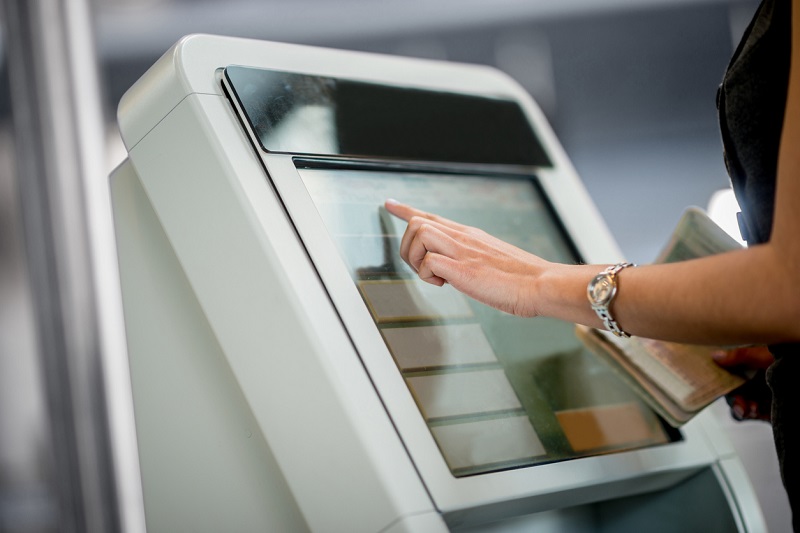
Which Government Departments Utilize Self-Service Kiosks?
Digital self-service kiosks can be found in many government offices, including:
- Federal buildings
- Departments of Motor Vehicles (DMVs)
- Post offices
- Courthouses
- City halls
- Public libraries
- Correctional institutions
Kiosk Services for Kiosks Government Agencies
Self-service kiosks can perform a variety of functions for government institutions:
Self-check out
Libraries were another early adopter of simple digital kiosks. As library cards made the move away from paper and toward digital over the past 15 years, many libraries integrated the cards with tablet computers equipped with barcode scanners, allowing patrons to checkout books without waiting in long lines for personal assistance.
Postage printing & stamp dispensing
The United States Postal Service was one of the first government agencies to begin using self-service kiosks regularly. Instead of requiring customers to wait in what can be extremely long lines in order to mail a simple package or buy a package of stamps, many locations are now equipped with kiosks that allow these types of transactions to be completed without assistance.
Driver’s license tests
Driver’s license tests have been given digitally for a number of years, now, but some DMVs have adopted a tablet or free-standing kiosk version of driver’s license testing. Instead of having to wait for one of only a handful of computers to be available, applicants can instead be given a tablet computer – a much less expensive option – to use in a designated testing area. Test results are then able to be made available almost immediately.
Car registration renewal
Many state governments now allow residents to renew their car registrations via digital kiosks. While some kiosks are located in the DMVs themselves, others, such as those in Georgia, are installed in grocery stores, making it even more convenient to pay for and receive a renewal.
Fee & bill payment
Bill payment kiosks were some of the first to be used regularly by government agencies. These kiosks allow users to pay fees for simple parking violations, such as parking tickets, as well as pay for utilities, like water and sewer bills.
Visitor management
Most public-facing government agencies see long lines, especially toward the end and very beginning of each month. DMVs and social security offices can be particularly busy. Self-service kiosks help keep offices running smoothly in an orderly manner by providing visitor management solutions such as printing tickets to give visitors their number in line, or providing digital check-in services.
Benefits of Digital Kiosks for Federal, State and Local Governments
Self-service kiosks have many advantages for all levels of government, including:
Greater efficiency & lower costs
Digital kiosks can perform many of the simpler and more repetitive tasks generally asked of staff. However, self-service kiosks are less expensive than full-time or even part-time employees. Kiosks allow government agencies, like DMVs, to help more people in a given amount of time, without increasing expenses
Security & privacy
Kiosks can be equipped with software that makes them extremely secure. Transactions that involve sensitive data, such as social security numbers or credit card information, can be easily protected.
Better visitor experience
Digital kiosks’ efficiency can help reduce long lines and wait times. Specialized kiosk software can provide services that even a large staff cannot, such as multiple language translation for various tasks from car registration renewal to utilities payment. In general. self-service kiosks enable a better overall user experience for visitors.
Why Choose REDYREF Self-Service Kiosks for Government Agencies
With more than 100 years of kiosk manufacturing experience, REDYREF is able to customize self-service solutions across a wide range of public sector needs. From DMVs and courthouses to bill payment and postage purchases, REDYREF helps government agencies reduce red tape, increase efficiency and lower costs. Interested in learning more? Request an online quote for your kiosk project, or call 1.800.628.3603 for additional information.
Efficiency and patient satisfaction are two primary goals of hospitals and medical clinics. Self-registration kiosks allow these facilities to run more efficiently, while providing more accurate information which can reduce mistakes and ultimately save lives.
Benefits of a Patient Self-Registration Kiosk
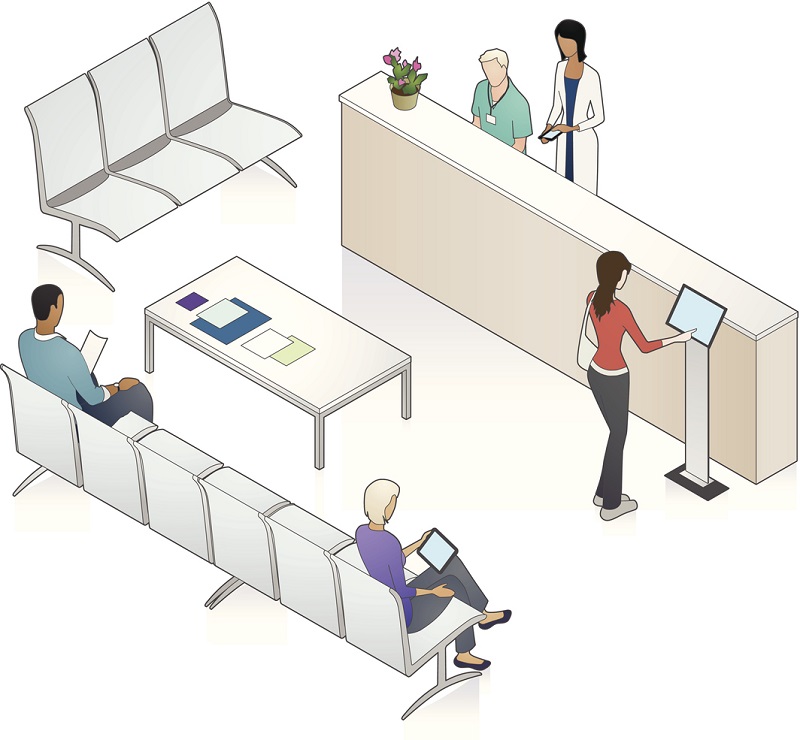
1. Faster registration for new patients
Digital registration kiosks cut down on paperwork for patients and manual data entry for staff. Automating registration also frees up staff to assist patients that need more help, such as the disabled.
2. Streamlined patient information updates
Digital kiosks make it much easier and faster for patients to update their information, such as insurance or address changes, without waiting for staff assistance.
3. Enhanced environmental safety via contactless temperature checks
Kiosks can handle not just self-registration, but other tasks like touchless temperature checks, which have become increasingly important over the course of the pandemic. Automated temperature checks help ensure a safe environment for both patients and workers, while freeing up staff to handle more pressing tasks.
4. Payment processing
Kiosks can accept payments, including touchless payments, which have become important for many organizations during COVID. Kiosks can process co-pays and payment for other services or products, reducing wait times as well as stress on staff.
5. Enable reminder for appointments for patients
Self-registration kiosks include software that connects to the facility’s practice management software. Therefore during registration or check in, patients can be given an opportunity to digitally opt-in to appointment reminders via text or email, reducing the chance that they will miss a future appointment.
6. Provide access to surveys and forms before the patient’s appointment
Surveys can play an important part in ensuring patient satisfaction. They can be used to quickly assess a patient’s current physical and emotional state so that their provider can review the information before the appointment. They can also can also allow patients to document and communicate their current satisfaction level with their care and how services can be improved for future visits.
7. Create staffing efficiencies
Digital kiosks free up hospital staff for higher-priority tasks. Kiosks can automate simpler functions so that staff can be assigned to projects that are a better use of their time.
What is a patient self-registration kiosk?
A patient self-registration kiosk is a self-service kiosk that allows patients to check in to a hospital or clinic digitally. These kiosks minimize paperwork and streamline payments while automating information collection and reducing data entry errors.
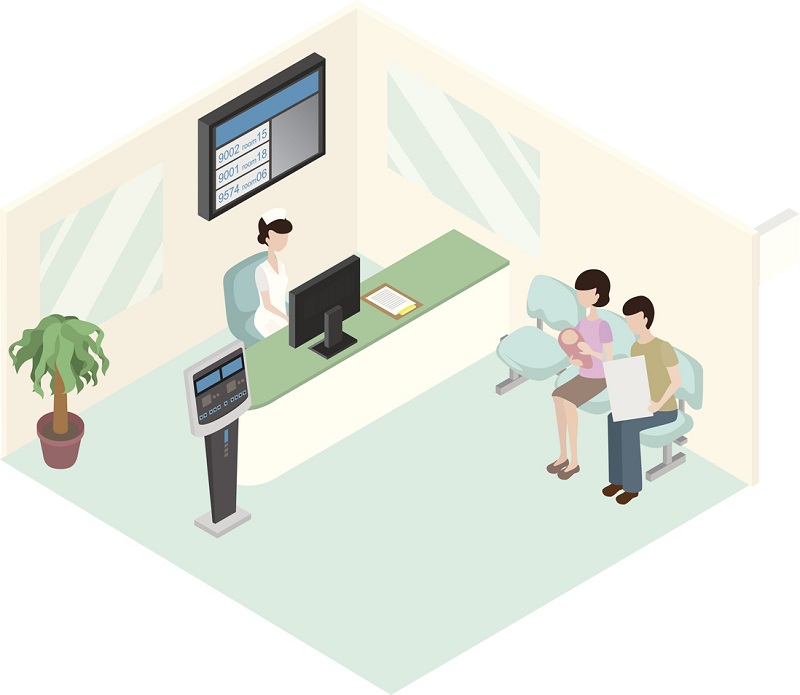
Patient Registration Kiosk Features
Features of a patient registration kiosks include:
- New or Existing Patient Check-In
- Updating New or Existing Patient Information
- Temperature Screening
- Payment Processing (co-pays or other services)
- Patient Health Surveys
Why REDYREF for Patient Self-Registration Kiosks
REDYREF has manufactured kiosks for more than 100 years, producing high-quality kiosk options for healthcare, business, travel, and hospitality, including self-registration kiosks. They work with each of their clients to understand their specific needs across industries and environments. Interesting in learning more? Get started by contacting REDYREF today.
Digital concierge kiosks are kiosks designed to create a better customer experience. These kiosks are custom-built with learning software which helps teach it to cater to a wide variety of requests. Today, we will look at what an interactive digital concierge kiosk can do for you.
What is an interactive digital concierge kiosk?
An interactive digital concierge kiosk is designed to fulfill the role of a guest services specialist. These kiosks are flexible, which makes them useful for a variety of different tasks, including welcoming, registering and guiding.

Who uses digital concierge kiosks?
There are three difference audiences for whom digital concierge kiosks can be helpful:
- Visitors: Visitors include vendors, visitors, and customers – essentially, anyone who isn’t a part of the organization deploying the kiosk. Some common environments for visitor concierge kiosks include office buildings, educational campuses, trade shows, museums, and hotels, and event venues.
- Residents: Residents include those who live or work in a certain space. This includes apartment buildings or condos, rent or own space within an office complex, office employees, and college students who attend school and/or live on campus.
- Participants: Participants are those who gather for professional events. These include congresses and conventions, trade shows, seminars, and job-related training.
What are the main types of digital concierge kiosks?
Concierge kiosks can be physical or purely digital:
Interactive Touch Screen Kiosks
Touchscreen kiosks most often feature capacitive touch screens that function similarly to the way a smart phone might. They are generally a very responsive type of touch screen. These kiosks are usual integrated with digital kiosk software designed to handle multiple concierge-related tasks, such as visitor management, visitor or guest self-check-in, and building directories and wayfinding. Examples of touch screen kiosks include those found in hotel and office lobbies.
Mobile Apps with QR Codes
Mobile app and QR codes provide a unique way to access the information available via a digital concierge. Instead of hosting the information on a full-size kiosk, the QR code for the app can simply be scanned by visitors from something as simple as a piece of paper, or as complex as a digital video wall. Once the app is downloaded onto the user’s personal device, usually from a Cloud-based storage service, they can access the information anywhere, taking it with them as they navigate the area. Visitors can also use it to check in or out of their hotel room, a conference, or office building. And for organizations that don’t have much useable space, mobile apps can be an excellent way to make information available, even without a physical kiosk present.
Concierge Kiosk Benefits
Concierge kiosks provide key benefits for both businesses and the end-users:

Help Visitors Get the Latest and Most Accurate Information
A valuable feature of digital kiosks is their ability to be quickly and easily updated, therefore providing always-up-to-date news and information. In a hotel, for example, a digital concierge kiosk could be used to provide information about local tourist attractions or restaurants, including website information and links to purchase tickets or make reservations.
Assist Guests in Navigating Their Environment
Nearly all kiosks can be integrated with directional and wayfinding software. Maps can be added in 2- or 3-D, and can include “turn-by-turn” instructions, directories, lighted paths, and may include important navigational landmarks. This technology is especially valuable for new visitors who are still becoming familiar with their environment, decreasing their stress and helping to ensure a more positive experience.
Offer Additional Branding and Marketing Opportunities for Businesses
Kiosks provide a unique opportunity in terms of marketing, because they can also display information about other available products and services. For example, a hotel check-in kiosk may also choose to promote spa services and specials, or available in-room purchases like flowers, wine, or room service. These kiosks can also display high definition video and photos to enhance or burnish the company’s brand.
Can Decrease Overhead
Kiosks can help keep overhead low by reducing the cost of hiring full-time staff. A digital concierge kiosk can many administrative tasks via automation, which then allows employees to handle requests that are better addressed by in-person customer service.
Examples of concierge kiosks
Although many may not realize it, digital concierge kiosks are everywhere, and chances are, most people have already used one.
Digital Visitor Management Kiosk
Also known as a virtual receptionist, visitor management kiosks can be as simple as a tablet with self-check-in, or as complex as a full freestanding kiosk system with facial recognition software. These kiosks can track who is in the building, inform employees or residents they they have guests, print ID badges, and give access to secure areas of buildings via scannable visitor passes.
Hotel Self-Check-In & Information Kiosks
Digital concierge kiosks can be integrated with software that handles guest check-in and check-out, area information, maps, hotel directories and information, and available guest amenities such as in-room food and beverage options and spa amenities. They can also help guests book and purchase tickets to events as well as make restaurant reservations.
Museum Information Kiosks
When placed in a museum, digital kiosks can provide directions within the museum, including information about exhibits and special events. They may also allow visitors to purchase digital or physical museum tickets, view restaurant or food options for on-site restaurants, become museum members or even donate to the organization itself.
Interactive digital concierge kiosks help provide a better experience for visitors and guests. Whether physical or digital, they help businesses connect with their customers to better serve them, keeping them coming back. Considering a digital concierge kiosk? Request more information or a quote from the top kiosk manufacture, REDYREF today.
Even prior to the COVID pandemic, movie theater ticket kiosks were becoming a common sight. Now, as movie fans begin to return to theaters to watch their favorites on the big screen, the adoption of these ticket kiosks has never been more essential, for both the fans, and the businesses behind the theaters.
What is a movie theater ticket kiosk?
A movie theater ticket kiosk automates printing and payment for movie tickets. Additionally, they can also handle changes to a ticket such as a different seat, movie or time slot.
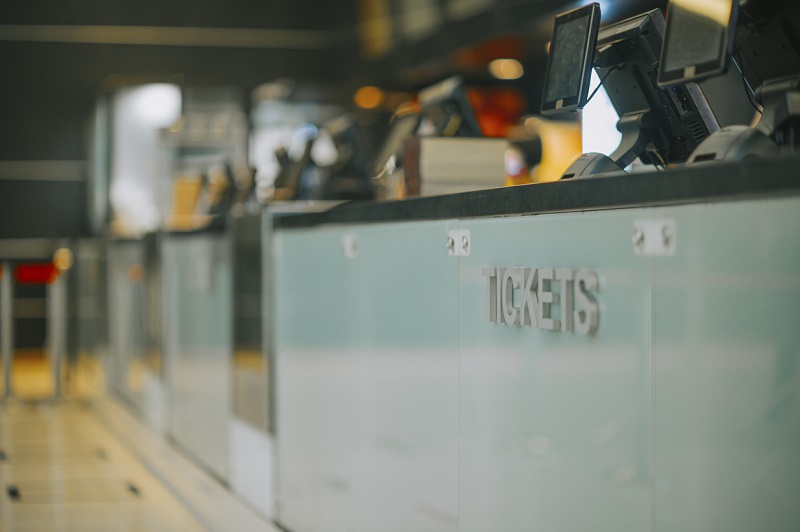
Why are movie ticket kiosks becoming more popular?
With COVID-19, movie theaters need to lower costs while maintaining the same level of efficiency. Kiosks allow them to continue to operate while lowering the high overhead that comes with having the theatre open. In addition, kiosks allow staff to be repurposed for more pertinent tasks such as customer service or maintaining the theatre while the kiosk handles ticket sales.
Benefits of Movie Theater Ticketing Kiosks
Movie theater kiosks have many benefits, most of which are centered around the customer experience and a reduction in overhead costs.
Self-Service
Self service allows customers to purchase whatever they wish without waiting in long, traditionally staffed lines. This results in a better customer experience, while also decreasing stress on available staff during busy times. Additionally, research has shown that customers are more likely to accept upselling or cross-selling suggestions when serving themselves, which can increase the theater’s profits. Afterall, the vast majority of profit in any movie theater comes from the concession stand.
Shorter Lines
It’s likely that standard ticket lines will still be available in most theaters. However, the addition of ticket kiosks decreases the workload of the traditional ticket agent by funneling away a portion of traffic, especially during the busiest times of day. Shorter lines also result in a much better customer experience which often leads to a greater chance that the customer will return in the future.
Reduced Labor Costs
Kiosks provide a self-service option that automates the ticketing process, meaning that fewer staff members are needed for what is a largely menial job. This can simultaneously reduce labor costs for the theater, and ensure that the best performing staff can be assigned to more important and interesting roles.
Cost Effective
As stated previously, kiosks can function 24/7. They are also able to serve a larger volume of customers than most employees. Although the initial investment is not inexpensive, the increase in concession revenue and attendance retention will allow the kiosk to pay for itself quickly.
Easy to Maintain
Aside from occasional software updates, ticket kiosks can run for months without any issues. However, problems occasionally occur, which is why many kiosk owners purchase a maintenance package from their kiosk’s manufacturer that covers a range of issues post-installation.
Expected by Customers
Automation and self-service have become an expected part of most experiences, from retail to restaurants. Many customers prefer self-service, making automation in many environments almost a requirement for some businesses. Installing a ticket kiosk in theaters provides businesses with practical benefits, but also makes the theater appear more modern and innovative.
Contactless
The pandemic has solidified the need for low- and no-contact ways for companies to handle transactions with their customers. Kiosks help ensure a reduction in close contact between individuals, ensuring that all parties are kept at minimum distance, safely.
Promote New and Upcoming Movies
Aside from practical functions, kiosks also provide an excellent platform for promoting brands and products. As a customer purchases their tickets, they can also be made aware of new and upcoming movies when ads are placed in unobtrusive areas of the screen.
Parts of a Ticket Kiosk
Below are the various parts that make up a ticket kiosk and allow it to function:
Hardware
The hardware refers to the physical aspects of the kiosk. This includes aspects such as a camera, printer, and NFC payment and bill reader. The hardware communicates with the rest of the kiosk, namely the software, to function.
Digital Display
The digital display is integrated with the hardware and allows users to communicate with and access the software inside.
Kiosk Enclosure:
The kiosk enclosure protects the internal aspects of the kiosk from damage, and will generally support the digital display as well.
Software
Kiosk is the software’s brain. It’s what makes the kiosk work, by processing various incoming commands from users, from payment collection to ticket printing.
How do ticket kiosks work?
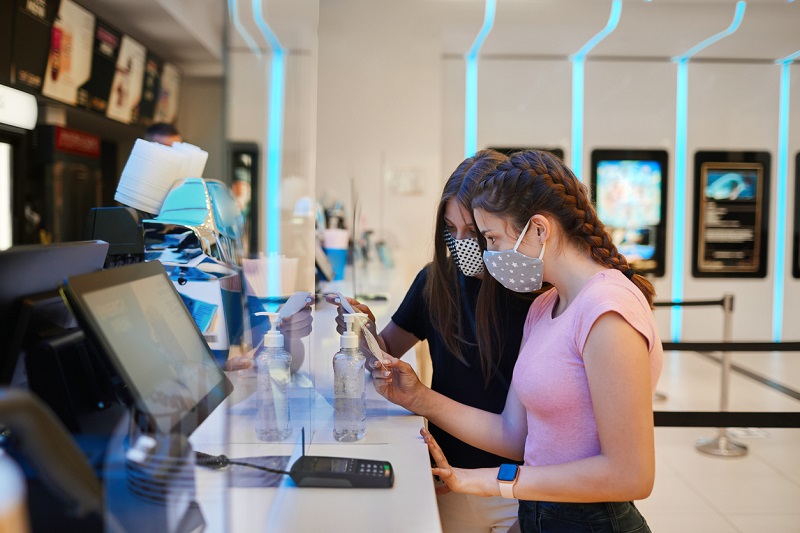
A well-designed movie ticket kiosk should always be easy to use.
1. Select the Movie and Time
Choose the desired movie by using the digital touch screen. The movie will have all time slots currently available. Here, you are generally able to pick your seats, as well.
2. Pay for Tickets
With movie, time and seats chosen, the customer can now pay for their tickets. A kiosk will have a bill reader and NFC payment reader as well, allowing users to pay with either cash or credit card.
3. Print Tickets
After the tickets have been paid for, the kiosk will print them, so that the customer can proceed to their seats or the concession stand.
What if you already purchased your tickets online?
- Use the assigned QR code to print tickets: For those who have already purchased their tickets online, a kiosk can allow them to print them in person if desired. Simply scan the QR code at the kiosk, after which time the kiosk will print the physical tickets.
- Can the kiosks help make ticket changes?: Aside from simply printing tickets, these kiosks can make updates to tickets, such as changing seats or time lots.
Movie theater ticket kiosks have become a staple of most theaters, allowing for self-service that makes for a better experience for customers, and a more stable bottom line for theaters.


















